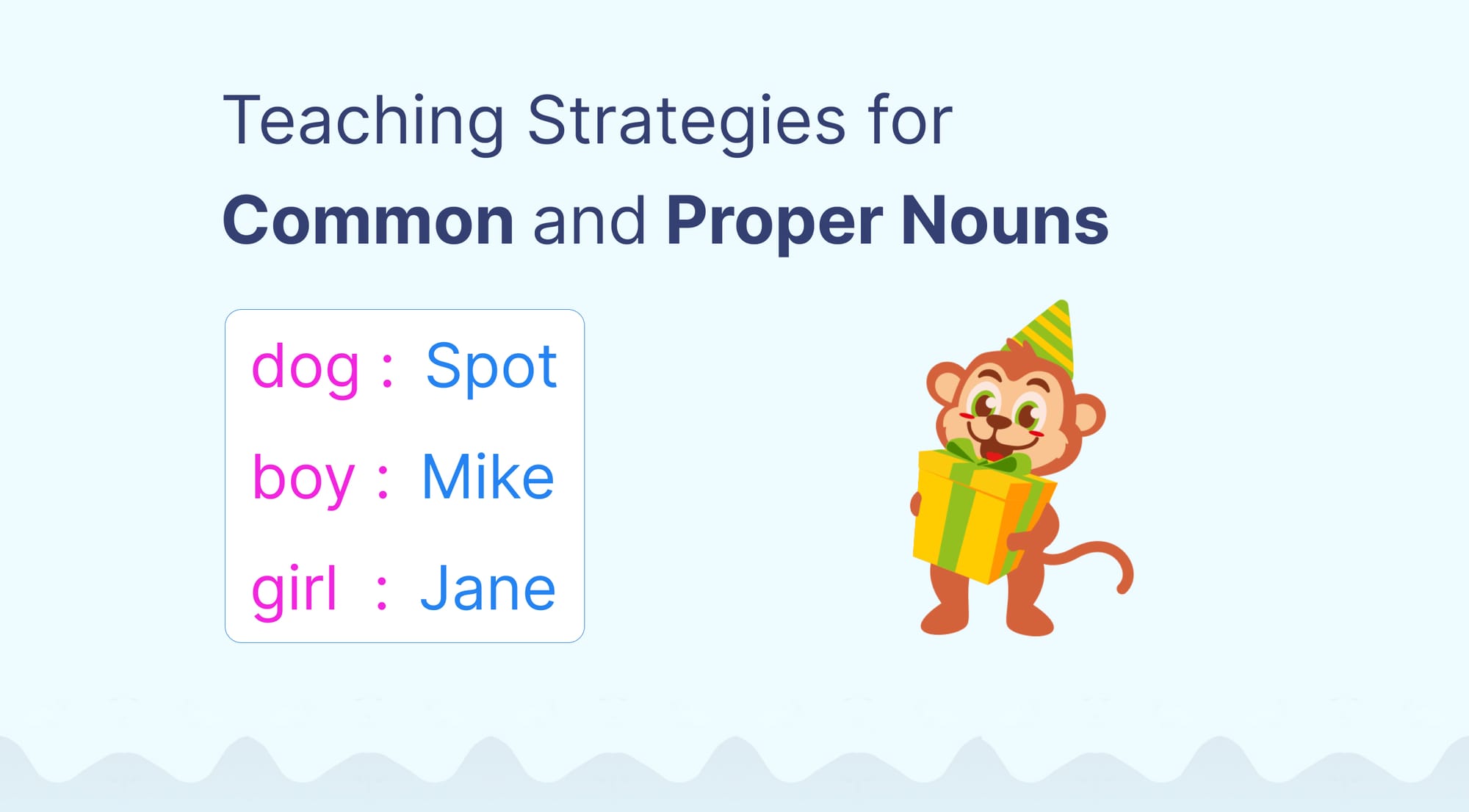Teaching Strategies for Common and Proper Nouns (2025)
Dive deeper into the writing skills of your little ones with teaching strategies for common and proper nouns. Get ready to teach your kids the difference between "dog" and "Snoopy The Dog" and to get them excited to learn.
Up to this point, you may have focused on teaching basic words and forming simple sentences. Now, it’s now time to expand their understanding and teach them the difference between common and proper nouns.
A big part of teaching is getting the kids engaged and having fun with it! We've put together popular strategies that kids will enjoy while also learning—kind of like slipping veggies into their meatloaf—they enjoy it and get the benefits at the same time.
If you're like me, you like a roadmap on your trips, so here is our roadmap to teaching common and proper nouns:
- What is a Noun?
- What are the Two Main Types of Nouns?
- What is a Common Noun?
- What is a Proper Noun?
- Common Nouns vs. Proper Nouns
- Identify Common and Proper Nouns
- When to Capitalize Nouns
- Engage Parents
What is a Noun?
Simply put, a noun is a word that names a person, place, thing, or idea. Nouns are the building blocks of sentences, helping us express our thoughts more clearly.
Early on, our kiddos can usually relate to sight words like ״dog,״ ״cat,״ ״house,״ and ״toys״ – these are words they easily associate with. We can incorporate these words into different teaching methods in order to explain nouns:
- Anchor Charts: These charts use images and words to teach nouns, including pictures of items children will recognize easily.
- Picture Cards: Like anchor charts, these cards use pictures to explain nouns, and they can be used to play matching games or as study guides.
- Worksheets: Printable worksheets are excellent for independent study. They can incorporate elimination, where children cross out what isn't a noun, or selection, where they choose the noun from a group of words and images..
You can use these tools independently or combine them for a series of lessons. Turn learning about nouns into a fun experience with games and prizes.

What are the Two Main Types of Nouns?
After setting the stage with a definition of a noun, you can introduce them to the types of nouns. At this point, focus on common and proper nouns; plural and singular nouns can come later if you prefer not to overwhelm their young minds.
What is a Common Noun?
A common noun is a general name for people, places, things, or ideas. Use examples like "boy," "school," or "dog."
Now that we have introduced the concept of common nouns, it's important to show our kids how common nouns are used daily in practically every sentence. Nouns are the everyday heroes of our language.
Point out various meanings of “common” to help them understand, such as:
- Appearing a lot
- Not special
You can create anchor charts using only common nouns. Include nouns that your little ones may see daily:
- car
- dog
- boy
- girl
- city
- shoe
The idea is to have them associate everyday things they can see with common nouns. They will pick up abstract nouns like "love" as they continue learning.
What is a Proper Noun?
A proper noun is a specific name for people, places, things, or ideas. Use examples like “Jack,” “Clover Elementary School,” or “Spot.”
If common nouns are your everyday heroes, proper nouns are the VIPs. Proper nouns typically give specific names to nouns, distinguishing them. They are capitalized to signify their importance.
Show your little ones the same set of words from the common nouns, but transform them into proper nouns.
- car: Volvo
- dog: Spot
- boy: Jim
- girl: Jane
- city: New York City
- shoe: Nike
Proper nouns take the general common noun and make it specific. Read aloud sentences like: “The dog ran.” – This could be any dog. Then read, “Spot ran.” – This is a specific dog that ran.
Associating proper nouns with activities and things our kiddos see daily will help them grasp the idea of proper nouns.
Common Nouns vs. Proper Nouns
There are times when differentiating between common vs proper nouns isn't as easy as it should be. Even we adults get it wrong on occasion.
Some common nouns can be proper, depending on their use in the sentence, or if certain words follow them. If you can easily replace the noun with the person's name in the sentence, it's a proper noun and should have a capital letter. For instance;
- I want to surprise Mom for her birthday. Here, mom is capitalized because it is used in place of her name.
- I wish all the moms out there a happy birthday. Here, mom is a general term.
- Aunt Peggy is my aunt. The first "Aunt," is capitalized because it is part of the name “Aunt Peggy,” and is the first word in the sentence. The second "aunt" in this sentence is used as a general term, and is a common noun.
Visual teaching aids, like flashcards, are extremely useful when teaching common nouns vs. proper nouns.
Identify Common and Proper Nouns
Having introduced the two main types of nouns, common and proper, you want to put them together and let your kids work with them side by side. This helps our kids practice identifying both types.
You can help your students learn the difference using:
- Worksheets - Use worksheets that present the kids with a list of common and proper nouns. The goal is for them to identify the type of noun. You can use these worksheets in the classroom or send them home for extra study.
- Sorting Games - Make a set of flashcards with common nouns and a second set with related proper nouns. During group time, have the kids sort the flashcards into matching sets.
When to Capitalize Nouns
By now, our kids may have begun to notice that some nouns are capitalized. While this may often come intuitively, it's important to explain why.
Revisit the explanation that proper nouns are special. They are given a capital letter to show that they are unique. Here are some tips for explaining:
- Names – most kindergarteners learn to write their names very early. Use this as an example of how names are capitalized. Take it one step further and explain that this includes names of places, things, and people.
- Anywhere in the sentence - Remember to stress that capitalizing proper nouns can occur anywhere in the sentence, not just at the beginning.
Try mixing it up a bit by using different worksheets to help the kids visualize capitalizing the proper nouns:
- Use worksheets that have a common and a proper noun, and the kids pick out the one that needs to be capitalized.
- Look for Fill-in-the-blank activities or games. These are a bit more advanced where the students pick the correct proper noun to complete each sentence.
Take time to visually show your students a common noun that is uncapitalized and a proper noun that is capitalized (like our previous example of dog and Spot). Repetition is key to embedding this skill into their language repertoire.
Engage Parents
Lastly, involve parents in the teaching process by sending home worksheets, flashcards, and notes explaining the concepts being taught. Encourage them to identify proper nouns when spending time with their children or watching videos together. You can also suggest videos for kids to watch at home.
Engaging parents in your journey to develop language writing skills gives kids an added boost. When parents are involved, you will notice much faster retention and better progress.
Conclusion
Have fun with it 😊 Try not to let common and proper nouns overwhelm your teaching; it’s an adventure for you and the little minds you are helping to mold. Make it fun, engage them in the learning process, and watch them become rock stars of the writing world.
Remember to use visual aids as much as possible, and keep the nouns and sentences short and sweet. Complex sentences and paragraphs will come eventually. Extend beyond the time set aside for learning nouns. Incorporate common and proper noun identification into other classroom activities. The more you show them, the more they will retain.
Be sure to follow our blog for more tips on teaching kindergartners language skills in writing. Happy teaching!

